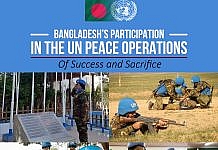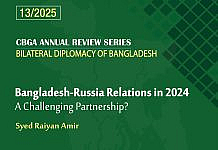
The people of Gaza find themselves amidst another distressing episode of Israeli atrocities, which are a tragic component of the long-standing and profoundly brutal Israel-Palestine conflict. This enduring conflict, one of the most severe and brutal political, regional, and international crises in modern history, has plunged the Palestinians into a seemingly endless cycle of violence and suffering. The recent escalation of violence began with an unprecedented rocket and ground attack launched by Hamas on Israel, from the Gaza Strip on October 7th, that claimed some 1400 Israeli lives. In response, Israeli Prime Minister Benjamin Netanyahu declared that “Israel is at war” and authorized relentless airstrikes that have decimated the Gaza Strip.
The consequences have been devastating, with over 10,000 Palestinian lives lost, 350,000 residents forcibly displaced, and another million individuals receiving warnings to relocate to safer areas within the southern region of Gaza or potentially face the wrath of 400,000 Israeli soldiers prepped to annihilate Hamas. The humanitarian situation in Gaza has reached the cusp of a humanitarian disaster, with the population enduring the dire lack of electricity, running water, and access to food supplies and hospitals and civilians are indiscriminately being subjected to the horrors of airstrikes. With the war entering its fourth week, the Israeli Defense Force (IDF) has expanded its ground invasion, since last Friday, and there awaits a bleak future with no prospect of a ceasefire in the foreseeable future.
The Conflict This Time
On the early morning of October 7th, Hamas initiated its “Operation Al-Aqsa Flood”—citing to be in response to the desecration of the Al-Aqsa Mosque, the ongoing blockade of the Gaza Strip, illegal Israeli settlements, and settler violence. This attack coincided with the 50th anniversary of the 1973 Yom Kippur War. Hamas conducted a surprise offensive, utilizing tactics like aerial drones to disable Israeli observation posts, paragliders for infiltration into Israel. According to Hamas, they fired over 5,000 rockets from the Gaza Strip into Israel within a span of 20 minutes, and around 2,500 of their members infiltrated Israel from Gaza using various means like trucks, pickup trucks, motorcycles, bulldozers, speedboats, and paragliders.
The attack had been brewing for some time, with significant tensions leading up to it. In 2023, prior to the attack, at least 247 Palestinians had been killed by Israeli forces, settler attacks had escalated, displacing hundreds of Palestinians, and there were clashes around the Al-Aqsa Mosque, a contested holy site in Jerusalem. Israeli officials confirmed that over 1,400 Israelis were killed in the attack, the highest casualty count since the Yom Kippur War, and approximately 230 civilians were taken hostage to the Gaza Strip. Following the attack, The Israeli government’s State Security Cabinet formally placed the country under a state of war for the first time since the 1973 Yom Kippur War. The IDF imposed a total blockade on the Gaza strip and West Bank— with its defense minister stating “We are fighting human animals and we are acting accordingly”.
The IDF mobilized its 160,000 troops, called up to 300,000 reservists, and declared its aim to eliminate Hamas’s military capabilities and overthrow its rule in Gaza. Subsequently, the IDF indiscriminately bombed the Gaza Strip and intensified its ground offensive, resulting in a rising death toll. According to the Gaza Ministry of Health, as of October 29th, more than 8,000 Palestinians have been killed in air and artillery strikes carried out by the IDF, with two-thirds of the casualties being children.
The Humanitarian Crisis
This year has been the bloodiest year ever for Palestinians living under occupation in Gaza. The IDF are beheading and burning mothers and infants in their houses and their airstrikes are disfiguring and mutilating bodies. According to Save the Children, since the war’s beginning, more children have died in the IDF assault and airstrikes than have died in armed conflict worldwide each year since 2019. Internet and telephone lines have been blocked, causing communication blackouts and after more than three weeks of war and a tight siege, the humanitarian catastrophes are beyond description. Israel has cut off electricity, water supply and stopped imports of food and medicine.
Before the conflict started, 500 trucks a day were reportedly pouring into Gaza, according to a BBC report. However, in recent days, an average of just 12 trucks transporting food, water, and medical supplies have entered each day, driving thousands of desperate Gazans to turn violent and break into UNRWA distribution centers and warehouses in order to steal basic survival supplies like hygiene kits and wheat flour. Additionally, there haven’t been any fuel supplies, which are necessary to power bakeries, hospitals, shelters, water treatment facilities, pumping stations, and the sewer system. Israel won’t let fuel into Gaza, claiming Hamas would use it for military purposes.
Since the IDF is conducting its clearance operation on the north end almost a million people are forced to evacuate the area and flee to the south making them internally displaced persons in an already densely populated area. Moreover, Israel has continued to target civilian buildings and hospitals, flattening the buildings and creating unimaginable long-term destruction in an area already with limited supply and making hundreds of thousands without any shelter.
Reactions of International Community
The war has brought the usual bifurcated reaction from the international community–revealing the distinct views of the conflict around the world. While the US and the western world condemned Hamas and decried its tactics as terrorism, with unequivocal support for Israel’s actions, citing self-defense, the neighboring regional players, anti-west global players and the Muslim world pinned full responsibility on Israel and sympathized with the Palestinian struggle. The unfolding situation has strong revelation around the diplomatic world also as Israel had to evacuate its diplomatic stuff from embassy in Egypt, Turkey and Jordan, following massive protest in front of the embassy and issue travel warning for its countries in various Muslim nations like Egypt, Jordan and Morocco, Turkey, UAE, Malaysia, Bangladesh, Indonesia and the Maldives. Following the Israeli atrocity, its relation with Arab neighbors has deteriorated, especially the efforts to normalize relations with the Arab nations like Saudi Arabia has collapsed as Saudi Arabia issued a statement that it has frozen the process of normalizing relations with Israel.
Possibility of a Ceasefire
In face of mass casualties and growing civilian death toll there is repeated call for an immediate ceasefire from all around the world. Concerns over the terrible humanitarian situation within the strip have been expressed even by Israel’s most ardent friends. The UN general assembly adopted a non-binding resolution, calling for a “humanitarian truce” in Gaza–leading to a cessation of hostilities between Israel and Gaza’s Hamas rulers. The resolution was adopted with a vote of 120 in favor, 14 against and 45 abstentions. Meanwhile the U.N. the Security Council is divided as usual, having failed to agree on a resolution four times in the last three weeks. Two were vetoed, while two were not approved with the necessary nine “yes” votes. The US vetoed the resolution sponsored by Russia, which called for a humanitarian ceasefire, on the other hand, Russia and China vetoed a US-drafted resolution that called for “humanitarian pauses” and Israel’s right to defend itself.
Netanyahu’s government is facing mounting pressure for a ceasefire but rejects all calls for ceasefire–saying it would be tantamount to surrender to Hamas, to surrender to terrorism, to surrender to barbarism– as Israel deepens attack on Gaza. On Monday the IDF announced it has entered into a “second stage” of the war–expanding their ground operation and battling Palestinian militants in dense residential areas. Meanwhile in Washington, the White House has ruled out a permanent ceasefire out of concern that it would only give Hamas time to replenish and regroup. With Washington backing and military assistance, Israel is conducting its war in full scale and the possibility of reaching a ceasefire evaporates in the thin air.
Hamas on the other hand has proposed for a ceasefire only after all Palestinian prisoners are exchanged for hostages, but Israel vows to fight until the battle is won and Hamas is eradicated from the strip. The UN chief Antonio Guterres has identified the Israeli attitude and called the situation as “collective punishment” of Palestinians. It is almost impossible to achieve Israel’s stated aim of the war–to cleanse Gaza from Hamas and dismantle its military wing and political structure, and with a bleak possibility of ceasefire in the coming days there is growing fear of the war escalating into a regional war with Iran backed groups in the Middle East.
Operation Swords of Iron—Israel’s operation to enter Gaza—appears to have a far more ambitious goal than anything the military has ever planned in Gaza, and it may not be feasible given that entering the Gaza Strip entails intense urban fighting from house to house and puts the lives of over two million civilians at risk. Crushing an intellectual movement is very difficult as Hamas espouses the concept of Palestinian independence, something that has never been accomplished in human history. Thus, regardless of how Israel’s battle with Hamas turns out or when a ceasefire is agreed upon, the struggle would continue.
– Wahid Uzzaman Sifat is a Research Intern at the KRF Center for Bangladesh and Global Affairs (CBGA).







